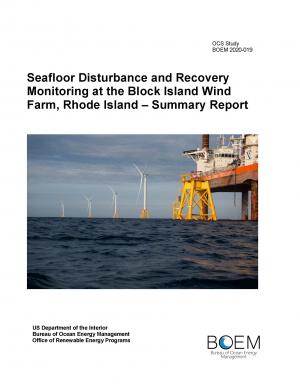Conducted by: HDR
Key Researchers: Anwar A. Khan, Kevin Smith
Funded by: BOEM
Seafloor disturbance and recovery monitoring was conducted in and around the Block Island Wind Farm (BIWF) to assess the impact of wind farm construction activities on the seafloor. Previous studies from Europe have shown that introduction of solid structures onto the seafloor, such as the four-legged BIWF turbine jacket foundations, can modify near-bottom current flow processes and induce scour. Five rounds of seafloor bathymetry surveys were conducted within a defined construction Work Area from a small research vessel using a Reson SeaBat 7125 ultra-high-resolution multibeam echosounder. Seafloor bathymetry data from the first and second surveys were primarily used to characterize the different types of seafloor disturbance features that resulted from construction activities. Data from the three rounds of post-construction surveys were used to evaluate the rate of seafloor recovery.
Findings
A relatively small area of the seafloor off Block Island was disturbed by wind farm construction activities.
Much of the disturbed area fully recovered within a relatively short time (1-2 years) in which no clear sign of any disturbance was evident as indicated by interpretation of the survey data.
How BOEM will use this information
The results from this study will improve the evaluation of the duration of seafloor impacts from offshore wind foundation installation.
The results and findings from this study could serve as the basis for extrapolation to larger wind facilities and will provide useful information on the effects of jacket type foundations which are generally underrepresented in European studies.
Additional information:
Final report: TBD


